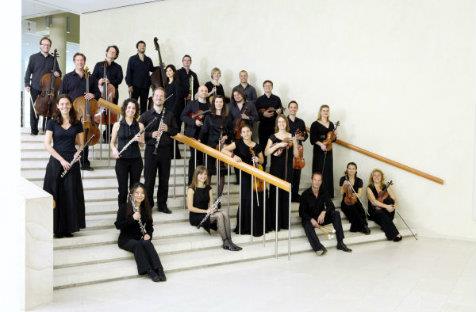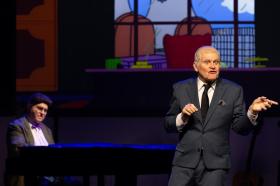Anyone who has been to a great deal of concerts in the Concert Hall of the Sydney Opera House – and this critic has been to a few over the years – will know that often the best indicator of the quality of a certain orchestra or ensemble is the appearance of flowers on the stage. One suspects that there is some type of musical fertilisation going on, whereby the really talented orchestras bring out the blossoms, as it were – they let the blooms crawl out of the woodwork. And such was yet again the case with the Mahler Chamber Orchestra, in their debut Australian performance.
(Another theory would be that the flowers are brought out for special occasions, and special occasions being what they are, they tend to be quite, well, special, as you might expect, and so there is, rather than a cause and effect, a mere coincidence going on. But this theory seems very banal to me, and I prefer the floral fantasy.)
I would tell you what the flowers were, too – give you a specific name for each and every one – but I am a young man, dear reader, a young man who has cultivated a dislike of aphids and has therefore created a gaping hole in my brain where botanical classifications should be. There was some green stuff, a bit of yellow, from memory, some brown perhaps, and maybe a bit of orange, among other things. And it was not so much flowers as it was plant-life, these two large profusions of gardenage set atop a distressed white plinth on either side of the stage. They were pretty, is what I mean to say. (The bouquets given to the soloists and conductor were also rather large and beautiful; so large, in fact, that the crowd found much mirth in watching the cellist struggle to carry both the bouquet and her instrument.)
Brett Dean, in the program, is quoted thus: ‘What a thrill for Australian audiences to get to hear the wonderful Mahler Chamber Orchestra, an orchestra that can do it all. In fact, they’re Europe’s answer to the ACO!’ One couldn’t agree more. In these two magnificent concerts over two thrilling nights, conductor Daniel Harding took us through a mix of the new and old and managed to stay consistently engaging and fresh throughout all of it. And to say ‘consistent’ is to give a huge compliment, for so often is brilliance, here in Sydney, a very short affair, lasting for only the length of one piece in a night, or only applying to a certain subsection of a performance. But with the Mahler Chamber Orchestra it’s not only full marks all around, but full marks for the whole time. I haven’t been so energised by a series of performances in quite a while, and I don’t think I’ve anticipated a second concert quite so much as, after leaving the Hall at the end of the first evening, I did the second program. (Harding, explaining to the audience that they didn’t know ‘how nice we were going to be,’ said that they hadn’t really planned an encore, but, due to demand, they were to give us a teaser for the second night – the second movement of Dvorak’s New World Symphony. He suggested that perhaps those who were attending the next day might want to leave beforehand, so as not to have the next concert spoiled. After the magnificent encore had finished, I was prepared to listen to it another five or 10 times, and I doubt I would have tired.)
The first night began on a new note, with a piece by Australian composer Brett Dean entitled Testament – Music for Orchestra. It is based on Beethoven’s Heiligenstadt Testament, a will that he wrote quite early in his life after learning about the lack of hope in regards to his worsening ability to hear. It is, to say the least, a rather haunting document, not least because of the mental pain he must have felt while writing it. The program tells us that ‘one particularly haunting sonic idea that struck [Dean] was the quietly feverish sound of Ludwig’s imagined quill, writing maniacally on leaves of parchment’. The piece itself has many of Dean’s hallmarks, including its nouveau creepiness and general ambivalence, but it is also tinged with quotes from Beethoven’s work. Harding’s interpretation remained tight throughout, creating an atmosphere which was all-encompassing, such that the piece was engaging from start to end.
The next work was Beethoven’s Violin Concerto in D, Op. 61, with Christian Tetzlaff taking centre-stage. Tetzlaff showed a mastery over the work, often quite rapid but, under his control, never feeling rushed. He has a great facility for the quieter moments as well. When, for instance, one is anticipating the next note at the end of a quiet phrase – a note that will no doubt be quite soft – Tetzlaff would, on occasion, add the slightest of an accent to it, barely perceptible. The effect was like bending down on a silent morning to examine a lone dandelion and, when it is but an inch away from your nose, having it gently puff out into your face. In the louder moments, too, he was as commanding as he was delicate in the smaller parts. There was a sense, that all great performances of concertos have, of a marathon effort, and by the end the audience was highly appreciative, garnering an encore of some passage of Bach’s from the violinist.
After the interval came Schumann’s Symphony No. 3 in E flat, Op. 97, Rhenish, which, to this critic’s taste, was merely excellent. (But what a problem for a critic, or audience member, to have, to be able to lament a performance as being ‘merely excellent’!) The outer two movements were charismatic, while the three inner movements (the work having five movements, for those of you counting at home) were a more moody affair. Perhaps in any other concert it is this symphony that I would remember the most, but against the Beethoven it comes second. The encore, as mentioned before, came from the second evening’s program. And what a second evening it was, even if the flowers, to the best of my limited knowledge, were precisely the same that were there the day before.
We began with Hans Werner Henze’s Sonata Per Archi (Sonata for Strings), a two movement work that begins with an allegro and ends with thirty-two variations, some only seconds in length. I found the Dean to be much more to my taste – I enjoyed his use of colours more, for instance – but there is no doubt that Henze’s piece couldn’t have asked for a much better performance, Harding once again getting a tautness and vim-in-an-instant from his orchestra that a piece like this requires.
Shostakovich’s Cello Concerto No. 1 in E flat, Op. 107 came next, with soloist Alisa Weilerstein taking to the stage in a long, flowing, purplish dress that spilled off the miniature platform on which she sat and propped her instrument against. Whereas Tetzlaff’s presence on the stage was one of a genial man brought to high exertion and enthusiasm, Weilerstein’s was one marked by intensity from the get-go. Indeed, her face was such a figure of concentration and committed focus that it seemed that, if she wanted to, she could crack a walnut just by staring at it. Her hair, too, in the more virtuosic moments, would collapse in front of her face, and her head would become a near-frenzy of bopping as she carved out the notes. It was a highly animated performance and a striking one, too. Her cadenza, bridging the gap between the second and fourth movement, was prolonged but never felt stretched, with gaps of seconds left between dramatic plucks sent out into the void; nary a cough could be heard in the audience during these moments. The audience called for an encore and got it, with yet again another work of Bach’s being played superbly.
After the interval came what this critic had been waiting for ever since the taste of it the day before – Dvorak’s Symphony No. 9 in E minor, Op. 95, From the New World. It was a revelation. Harding has a way of getting the most out of this orchestra that few conductors I’ve seen have. (This is, no doubt, also due to the immense talent of the musicians.) Indeed, he gets that little bit more oomph out of seemingly everything – by the end of the two concerts, one couldn’t help but feel that the Mahler Chamber Orchestra simply moved more than other groups. The violins, for instance, would use their whole bodies to whip into the climaxes and fortissimos, leaning forward then, pulling back with their torsos, drawing their bow the other way, like a gardener might shove a lawnmower away from him while trying to yank the cord to start it. Harding, too, has an infectious intensity, such that one could observe him almost punching the concertmaster in the face to signal the first violins, his clenched fist well over her music stand.
The adagio, heard the night before and once again in context, was the highlight of the work, remarkable not only for its lyricism but for its quietness as well – the Mahler Chamber Orchestra is perhaps the most quiet orchestra, when they need to be, that I’ve heard. Near the end of the second movement the strings give up the ghost for a few moments, and this cessation of sound produced a gasp from the woman sitting behind me during its first hearing in the encore, so involved was many an audience member in its music. But the whole of it was a triumph, and the ecstatic audience got its encore. All in all, a fantastic two nights, and one can but hope that the Mahler Chamber Orchestra makes their way to our shores again sometime in the very near future.
Rating: 5 stars out of 5
Mahler Chamber Orchestra
Daniel Harding (conductor)
Christian Tetzlaff (violin)
Alisa Weilerstein (cello)
Program 1:
Brett Dean – Testament – Music for Orchestra
Ludwig van Beethoven – Violin Concerto in D, Op. 61
Robert Schumann – Symphony No.3 in E flat, Op.97, Rhenish
Program 2:
Hans Werner Henze – Sonata per Archi (Sonata for Strings)
Dmitri Shostakovich – Cello Concerto No.1 in E flat, Op. 107
Antonin Dvorak – Symphony No.9 in E minor, Op.95, From the New World
Concert Hall, Sydney Opera House
10 – 11 June





